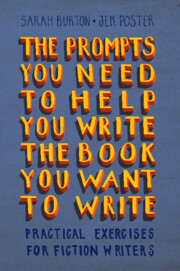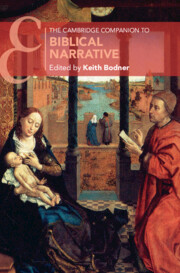Refine search
Actions for selected content:
28 results
2 - Character
-
- Book:
- The Prompts You Need to Help You Write the Book You Want to Write
- Published online:
- 25 October 2025
- Print publication:
- 06 November 2025, pp 15-28
-
- Chapter
- Export citation
3 - Structuring plot
-
- Book:
- The Prompts You Need to Help You Write the Book You Want to Write
- Published online:
- 25 October 2025
- Print publication:
- 06 November 2025, pp 29-46
-
- Chapter
- Export citation
Nuclear fear and anxiety: Exercises in future thinking
- Part of
-
- Journal:
- Memory, Mind & Media / Volume 4 / 2025
- Published online by Cambridge University Press:
- 04 November 2025, e19
-
- Article
-
- You have access
- Open access
- HTML
- Export citation

The Prompts You Need to Help You Write the Book You Want to Write
- Practical Exercises for Fiction Writers
-
- Published online:
- 25 October 2025
- Print publication:
- 06 November 2025
Introduction
-
-
- Book:
- The Cambridge Companion to Biblical Narrative
- Published online:
- 30 January 2025
- Print publication:
- 06 February 2025, pp 1-11
-
- Chapter
-
- You have access
- HTML
- Export citation

The Cambridge Companion to Biblical Narrative
-
- Published online:
- 30 January 2025
- Print publication:
- 06 February 2025
4 - The Cuckold in Machiavelli’s Mandragola
- from Part I - Machiavelli’s Enterprise and “the World”
-
- Book:
- Machiavelli's Effectual Truth
- Published online:
- 07 September 2023
- Print publication:
- 21 September 2023, pp 95-124
-
- Chapter
- Export citation
Chapter 15 - The World War Project
- from Part II - The Literary Works
-
-
- Book:
- W. G. Sebald in Context
- Published online:
- 24 August 2023
- Print publication:
- 07 September 2023, pp 127-134
-
- Chapter
- Export citation
Chapter 4 - Torture and the Sense of an Ending
-
- Book:
- Law and Mimesis in Boccaccio's Decameron
- Published online:
- 07 August 2023
- Print publication:
- 01 June 2023, pp 111-150
-
- Chapter
- Export citation
Chapter 4 - Minds
-
- Book:
- Ancient Greek Texts and Modern Narrative Theory
- Published online:
- 11 May 2023
- Print publication:
- 25 May 2023, pp 81-114
-
- Chapter
- Export citation
Chapter 5 - Motivation
-
- Book:
- Ancient Greek Texts and Modern Narrative Theory
- Published online:
- 11 May 2023
- Print publication:
- 25 May 2023, pp 115-147
-
- Chapter
- Export citation
4 - Literary Criticism
- from Part I - Methods
-
-
- Book:
- The New Cambridge Companion to Biblical Interpretation
- Published online:
- 15 October 2022
- Print publication:
- 22 December 2022, pp 73-90
-
- Chapter
- Export citation
Chapter 25 - Molière and His Critics: The ‘Querelles’
- from Part V - Reception and Dissemination
-
-
- Book:
- Molière in Context
- Published online:
- 10 November 2022
- Print publication:
- 24 November 2022, pp 238-245
-
- Chapter
- Export citation
– 3 – - Character
-
- Book:
- The Book You Need to Read to Write the Book You Want to Write
- Published online:
- 17 February 2022
- Print publication:
- 17 March 2022, pp 17-34
-
- Chapter
- Export citation
– 5 – - Plot and structure II
-
- Book:
- The Book You Need to Read to Write the Book You Want to Write
- Published online:
- 17 February 2022
- Print publication:
- 17 March 2022, pp 55-69
-
- Chapter
- Export citation
– 4 – - Plot and structure I
-
- Book:
- The Book You Need to Read to Write the Book You Want to Write
- Published online:
- 17 February 2022
- Print publication:
- 17 March 2022, pp 35-54
-
- Chapter
- Export citation
Chapter 8 - No Home Away from Home
- from Part II - Intersections, Intimacies
-
-
- Book:
- Asian American Literature in Transition, 1996–2020
- Published online:
- 27 May 2021
- Print publication:
- 17 June 2021, pp 150-170
-
- Chapter
- Export citation
6 - Madame de Lafayette and La Princesse de Clèves as Landmark
- from Part I - Beginnings: From the Late Medieval to Madame de Lafayette
-
-
- Book:
- The Cambridge History of the Novel in French
- Published online:
- 04 February 2021
- Print publication:
- 25 February 2021, pp 113-130
-
- Chapter
- Export citation
Chapter 1 - Writing and the Responsibility to Memory: The Role of White Female Planters in Contemporary Caribbean Novels
- from Part I - Literary and Generic Transitions
-
-
- Book:
- Caribbean Literature in Transition, 1970–2020
- Published online:
- 16 December 2020
- Print publication:
- 14 January 2021, pp 21-36
-
- Chapter
- Export citation
3 - Stories and Narration: In the Heart of the Country, The Master of Petersburg, The Childhood of Jesus
- from Part I - Forms
-
-
- Book:
- The Cambridge Companion to J. M. Coetzee
- Published online:
- 26 April 2020
- Print publication:
- 30 April 2020, pp 45-63
-
- Chapter
- Export citation
